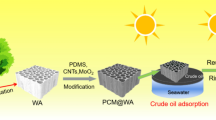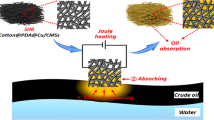Abstract
It is a worldwide challenge to achieve an efficient cleaning of heavy oil at ambient temperature. Conventional cleanup methods for high-viscosity oil spills exhibit low absorption efficiency and have severe practical operating limits. Herein, inspired by the passive transport process in the Salvinia cucullata, a solar-heated and joule-heated textile-based absorber using the scalable electrostatic flocking technique. Benefiting from the efficient photothermal and electrothermal conversion effects, the textile-based absorber, with oleophilic and aligned channels, facilitates thermal conduction and hence enhances heavy oil absorption. The absorber is highly efficient for organic solvents (chloroform and dichloromethane) and low-viscosity oils (silicone oil, gasoline, and diesel oil). The surface temperature of the textile absorber rises rapidly to 92 °C (114 °C) in 120 s (240 s) under one sun irradiation (or 5 V voltage), resulting in a sharp drop in the viscosity of the heavy oil and then achieving an ultrahigh absorption rate (2647 kg h−1 m−2) and fast equilibrium time (25 s). Rapid absorption rate significantly reduces spill cleanup time and spill spreading area, hence alleviating the environmental harm caused by oil spills as much as possible. The proposed solar-heated and joule-heated textile-based absorbers with aligned channels show great potential for efficient heavy oil absorption.
Graphical Abstract






Similar content being viewed by others
Data availability
The datasets generated in this study are available from the lead contact on reasonable request.
References
Fisher CR, Montagna PA, Sutton TT. How did the deepwater horizon oil spill impact deep-sea ecosystems? Oceanography. 2016;29:182.
Li P, Cai Q, Lin W, Chen B, Zhang B. Offshore oil spill response practices and emerging challenges. Mar Pollut Bull. 2016;110:6.
Lee CE, Remfert JL, Opgenorth T, Lee KM, Stanford E, Connolly JW, Kim J, Tomke S. Evolutionary responses to heavy oil from the deepwater horizon oil spill by the copepod Eurytemora affinis. Evol Appl. 2017;10:813.
Wan Z, Chen J. Human errors are behind most oil-tanker spills. Nature. 2018;560:161.
Doshi B, Sillanpaa M, Kalliola S. A review of bio-based materials for oil spill treatment. Water Res. 2018;135:262.
Cui Y, Wang YJ, Shao ZY, Mao AR, Gao WW, Bai H. Smart sponge for fast liquid absorption and thermal responsive self-squeezing. Adv Mater. 2020;32:9.
Zhao JC, Wang GL, Chen ZL, Huang YF, Wang CD, Zhang AM, Park CB. Microcellular injection molded outstanding oleophilic and sound-insulating PP/PTFE nanocomposite foam. Compos Part B-Eng. 2021;215:108786.
He YY, Li S, Zhou L, Wei C, Yu CB, Chen YH, Liu HX. Cellulose nanofibrils-based hybrid foam generated from pickering emulsion toward high-performance microwave absorption. Carbohydr Polym. 2021;255:117333.
Wu Y, Huang J, Chen JJ, Li D, Shi XW, Du YM, Deng HB. Ordered hollow nanofiber aerogel with revivability for efficient oil absorption. J Clean Prod. 2021;290:10.
Zhang DL, Lin Y, Wang W, Li YX, Wu GZ. Mechanically strong polyimide aerogels cross-linked with dopamine-functionalized carbon nanotubes for oil absorption. Appl Surf Sci. 2021;543:10.
Zhan C, Jana SC. Shrinkage reduced polyimide-graphene oxide composite aerogel for oil absorption. Microporous Mesoporous Mater. 2020;307:110501.
Song P, Cui JW, Di J, Liu DB, Xu MZ, Tang BJ, Zeng QS, Xiong J, Wang CD, He Q, Kang LX, Zhou JD, Duan RH, Chen BB, Guo SS, Liu FC, Shen J, Liu Z. Carbon microtube aerogel derived from kapok fiber: an efficient and recyclable sorbent for oils and organic solvents. ACS Nano. 2020;14:595.
Yin ZC, Pan YP, Bao MT, Li Y. Superhydrophobic magnetic cotton fabricated under low carbonization temperature for effective oil/water separation. Sep Purif Technol. 2021;266:118535.
Kuang Y, Chen C, Chen G, Pei Y, Pastel G, Jia C, Song J, Mi R, Yang B, Das S, Hu L. Bioinspired solar-heated carbon absorbent for efficient cleanup of highly viscous heavy oil. Adv Funct Mater. 2019;29:1900162.
Zeiger C, da Silva ICR, Mail M, Kavalenka MN, Barthlott W, Holscher H. Microstructures of superhydrophobic plant leaves—inspiration for efficient oil spill cleanup materials. Bioinspir Biomim. 2016;11:056003.
Barthlott W, Moosmann M, Noll I, Akdere M, Wagner J, Roling N, Koepchen-Thoma L, Azad MAK, Klopp K, Gries T, Mail M. Adsorption and superficial transport of oil on biological and bionic superhydrophobic surfaces: a novel technique for oil-water separation. Philos Trans R Soc A. 2020;378:0447.
Guo Y, Javed M, Li X, Zhai S, Cai Z, Xu B. Solar-driven all-in-one interfacial water evaporator based on electrostatic flocking. Adv Sustain Syst. 2021;5:2000202.
Yang Y, Li XJ, Zheng X, Chen ZY, Zhou QF, Chen Y. 3D-printed biomimetic super-hydrophobic structure for microdroplet manipulation and oil/water separation. Adv Mater. 2018;30:1704912.
Sun SJ, Li H, Zhang MM, Sun BB, Xie YB, Zhou W, Yang PP, Mi HY, Guo ZH, Liu CT, Shen CY. A multifunctional asymmetric fabric for sustained electricity generation from multiple sources and simultaneous solar steam generation. Small. 2023;19:2303716.
Sun SJ, Tian QL, Mi HY, Li J, Jing X, Guo ZH, Liu CT, Shen CY. Fabric-based all-weather-available photo-electro-thermal steam generator with high evaporation rate and salt resistance. Sci China Mater. 2022;65:2479.
Sun SJ, Wang YM, Sun BB, Zhang FF, Xu Q, Mi HY, Li H, Tao XM, Guo ZH, Liu CT, Shen CY. Versatile janus composite nonwoven solar absorbers with salt resistance for efficient wastewater purification and desalination. ACS Appl Mater Interfaces. 2021;13:24945.
Wang K, Wang DY, Wang MZ, Dan XX, Che LM, Xu HH, Zhou H, Liu H, Singh L, Wu XE. Functional photothermal sponges for efficient solar steam generation and accelerated cleaning of viscous crude-oil spill. Solar Energy Mater Solar C. 2020;204:110203.
Chang J, Shi Y, Wu M, Li R, Shi L, Jin Y, Qing W, Tang C, Wang P. Solar-assisted fast cleanup of heavy oil spills using a photothermal sponge. J Mater Chem A. 2018;6:9192.
Wang Y, Zhou L, Luo X, Zhang Y, Sun J, Ning X, Yuan Y. Solar-heated graphene sponge for high-efficiency clean-up of viscous heavy oil spill. J Clean Prod. 2019;230:995.
Yang J, Xu P, Yao YL, Li Y, Shi B, Jia XH, Song HJ. A solar-heated Janus sponge with excellent floating stability for efficient cleanup of heavy oil. Mater Des. 2020;195:108979.
Li Q, Sun Q, Li Y, Wu T, Li S, Zhang H, Huang F. Solar-heating crassula perforata-structured superoleophilic CuO@CuS/PDMS nanowire arrays on copper foam for fast remediation of viscous heavy oil spill. ACS Appl Mater Interfaces. 2020;12:19476.
Ge J, Shi LA, Wang YC, Zhao HY, Yao HB, Zhu YB, Zhang Y, Zhu HW, Wu HA, Yu SH. Joule-heated graphene-wrapped sponge enables fast clean-up of viscous crude-oil spill. Nat Nanotechnol. 2017;12:434.
Ma X, Zhang C, Gnanasekar P, Xiao P, Luo Q, Li S, Qin D, Chen T, Chen J, Zhu J, Yan N. Mechanically robust, solar-driven, and degradable lignin-based polyurethane adsorbent for efficient heavy oil spill remediation. Chem Eng J. 2021;415:128956.
Su Y, Chang Q, Xue C, Yang J, Hu S. Solar-irradiated carbon dots as high-density hot spots in sponge for high-efficiency cleanup of viscous heavy oil spill. J Mater Chem A. 2022;10:585.
Sun SJ, Sun BB, Wang YM, Antwi-Afari MF, Mi HY, Guo ZH, Liu CT, Shen CY. Carbon black and polydopamine modified non-woven fabric enabling efficient solar steam generation towards seawater desalination and wastewater purification. Sep Purif Technol. 2022;278:119621.
Cai C, Wei Z, Huang Y, Fu Y. Wood-inspired superelastic MXene aerogels with superior photothermal conversion and durable superhydrophobicity for clean-up of super-viscous heavy oil. Chem Eng J. 2021;421:127772.
Wu X, Lei Y, Li S, Huang J, Teng L, Chen Z, Lai Y. Photothermal and Joule heating-assisted thermal management sponge for efficient cleanup of highly viscous heavy oil. J Hazard Mater. 2021;403:124090.
Wu M-B, Huang S, Liu T-Y, Wu J, Agarwal S, Greiner A, Xu Z-K. Compressible carbon sponges from delignified wood for fast cleanup and enhanced recovery of heavy oil spills by Joule heat and photothermal effect. Adv Funct Mater. 2021;31:2006806.
Wang PL, Ma C, Yuan Q, Mai T, Ma MG. Novel Ti3C2Tx MXene wrapped wood sponges for fast cleanup of heavy oil spills by outstanding Joule heating and photothermal effect. J Colloid Interface Sci. 2022;606:971.
Li KQ, Li M, Lin CJ, Liu GZ, Li Y, Huang BL. A janus textile capable of radiative subambient cooling and warming for multi-scenario personal thermal management. Small. 2023;19:2206149.
Ji T, Feng Y, Qin M, Li S, Zhang F, Lv F, Feng W. Thermal conductive and flexible silastic composite based on a hierarchical framework of aligned carbon fibers-carbon nanotubes. Carbon. 2018;131:149.
Uetani K, Ata S, Tomonoh S, Yamada T, Yumura M, Hata K. Elastomeric thermal interface materials with high through-plane thermal conductivity from carbon fiber fillers vertically aligned by electrostatic flocking. Adv Mater. 2014;26:5857.
Acknowledgements
Fundamental Research Funds for the Central Universities 2232023G–01, The project was funded by the National Natural Science Foundation of China (NSFC) 52003045, Shanghai Frontier Science Research Center for Modern Textiles, Shanghai Sailing Program 20YF1400700, and the Application Fundamental Projects of China National Textile and Apparel Council.
Author information
Authors and Affiliations
Contributions
Xin Yang: Methodology, Investigation, Writing—original draft. Yanking Tian, Feng Xia, Yifei Gong, Chengming Zhang: Investigation. Rong Zhou: Methodology, Investigation. Feng Ji, Liu Liu, Jianyong Yu: Methodology, Supervision. Faxue Li, Ruiyun Zhang, Tingting Gao: Conceptualization, Investigation, Supervision, Writing—review and editing.
Corresponding authors
Ethics declarations
Conflict of interest
The authors state that there are no conflicts of interest to disclose.
Additional information
Publisher's Note
Springer Nature remains neutral with regard to jurisdictional claims in published maps and institutional affiliations.
Supplementary Information
Below is the link to the electronic supplementary material.
Supplementary file 2 (MP4 2366 KB)
Supplementary file 3 (MP4 1316 KB)
Supplementary file 4 (MP4 5849 KB)
Rights and permissions
Springer Nature or its licensor (e.g. a society or other partner) holds exclusive rights to this article under a publishing agreement with the author(s) or other rightsholder(s); author self-archiving of the accepted manuscript version of this article is solely governed by the terms of such publishing agreement and applicable law.
About this article
Cite this article
Yang, X., Tian, Y., Zhou, R. et al. Bioinspired Design of Textile-Based Absorbers: Photothermal and Electrothermal Synergistic Conversion for Efficient Clean-Up of Heavy Oil. Adv. Fiber Mater. (2024). https://doi.org/10.1007/s42765-024-00423-7
Received:
Accepted:
Published:
DOI: https://doi.org/10.1007/s42765-024-00423-7




